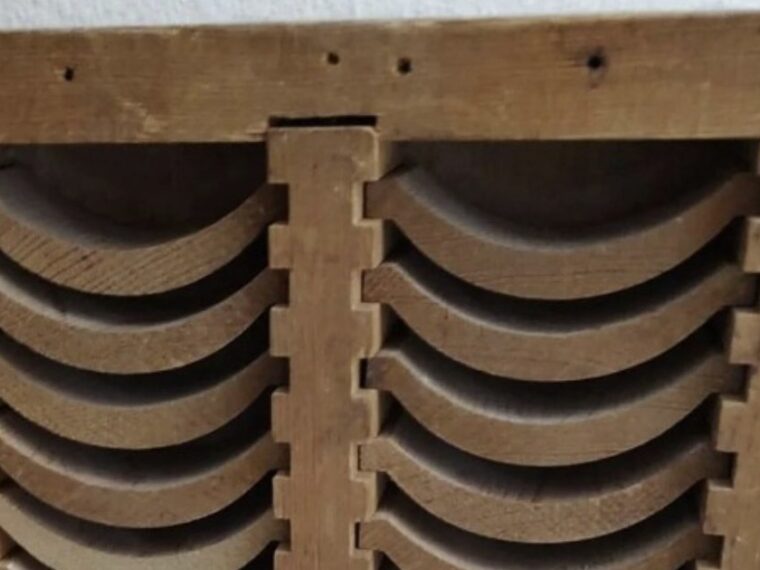Okay, here’s the confession: I didn’t even know what an ancient craftsman’s rack was until I found myself wandering in a dusty antique store one hazy afternoon. The kind of place that smells like old leather, faded paperbacks, and mystery—where you sneeze once and suddenly feel like Indiana Jones on the hunt for some lost artifact.
Amid the clutter—a broken phonograph, an off-kilter spinning wheel, stacks of cracked pottery—I spotted it. A plain, wooden frame, nothing fancy. No shiny brass plaques, no explanatory tags. Just this simple frame with odd notches and pegs carved into the wood, radiating this aura of quiet mystery. Something about it made me stop and wonder: what on earth was this for?
What Was the Ancient Craftsman’s Rack Used For?
If you’re scratching your head right now, you’re in good company. I had the same reaction.
Picture this: way, way back in the day, before industrial manufacturing and modern construction materials, every roof tile was made by hand. Potters shaped moist clay into roof tiles, then they had to dry these tiles just right before firing them in a kiln. That drying process was critical because improperly dried tiles could crack or explode under the intense kiln heat, ruining not just the tile but potentially the entire batch.
The ancient craftsman’s rack was a humble yet vital tool in this process. It was a sturdy wooden frame, crafted with precise notches and pegs, designed to hold these fragile tiles while they cured. The moist clay tiles would be placed delicately on these racks, allowing air to circulate and moisture to evaporate evenly across the surfaces.
This was not just a drying rack; it was a craftsman’s lifeline to quality and survival. Imagine the medieval weather—relentless rains, biting winds. A strong, well-made roof could mean the difference between safety and ruin during a storm. The rack was a backstage hero, supporting the creation of every durable tile that would eventually shield homes from the elements.
A Testament to Ingenuity and Adaptability
What fascinated me most is how these racks weren’t uniform. Every craftsman tailored theirs to fit their specific needs. Some made their racks wider or taller to accommodate larger tiles or different clay formulas. Others included clever little tweaks—adjusting the peg sizes, the spacing of the slats, or the angle of the supports—to maximize airflow or accommodate the quirks of the local clay.
This was old-school ingenuity at its finest. Without power tools, computers, or blueprints, these artisans relied on experience, trial and error, and an intimate understanding of their materials to develop the best drying solution possible.
My Deep Dive into the History of the Ancient Craftsman’s Rack
Once I realized how valuable and significant these racks were, I went down a rabbit hole—a full-on, late-night, cereal-for-breakfast level of research. Turns out, the ancient craftsman’s rack was much more than just a drying platform; it was part of a delicate, almost ritualistic process.
If the drying was uneven or rushed, the tile would crack. If the tile was left too long or dried improperly, it wouldn’t survive the kiln firing. And a cracked or exploded tile wasn’t just an inconvenience—it was a catastrophic waste of precious materials and time, and it could lead to a leaky, unsafe roof.
Imagine trying to explain this level of patience and precision to a medieval version of Karen, demanding a “fast and flawless” tile on demand! The stakes were high, and the margin for error was razor-thin.
I won’t lie—there was something unexpectedly emotional about learning this. Holding a piece of old wood that had carried the weight of an artisan’s hope, their skill, and their livelihood made me tear up. Is it weird to feel that connection to centuries-old craftsmanship? Maybe. But it’s a feeling I think many of us can relate to when we see the tangible evidence of history’s human touch.
Why This Matters Today
Now, I know what you’re thinking: why should anyone care about some old wooden rack when power tools and Amazon Prime exist at our fingertips? Fair enough.
But there’s something grounding about these relics of the past—about seeing firsthand how people lived, worked, and survived without the gadgets and conveniences we take for granted. The craftsman’s rack reminds us of a time when patience, skill, and pride in a job well done were the ultimate flex. No social media likes, no viral TikTok dances, just raw, hands-on hustle.
In a world obsessed with speed and efficiency, it’s comforting—and maybe even inspiring—to remember a slower, more tactile approach to creation.
The Essence of the “Good Old Days”
You know that feeling when you visit your grandparents’ house and stumble upon some odd artifact that triggers a cascade of stories and nostalgia? Like that ancient coffee grinder your grandpa swears makes the best coffee east of the Mississippi?
That’s exactly the vibe I get from the ancient craftsman’s rack. It’s not just a piece of wood with pegs. It’s a conversation starter, a window into a world that valued craftsmanship over convenience, patience over speed.
More than that, it’s a reminder that what we create—whether a roof, a family, or a community—leaves a legacy long after we’re gone. These simple racks silently tell stories of dedication, tradition, and the human spirit’s drive to build something lasting.
And between you and me, that’s way cooler than whatever you’re scrolling through on your phone at 2 a.m.
My Dream (Someday…)
Someday, I want to bring one of these ancient racks home. Maybe mount it in a cozy corner of my garage near my embarrassingly puny toolbox (hey, I’m trying). Even if I never use it practically, just having it around would be a way to keep a piece of history close.
It’s a tactile reminder of where we came from and who we still are beneath all the layers of modern life. Because sometimes, the unadorned, handmade things speak louder than any shiny gadget ever could.
The Cultural Significance of the Craftsman’s Rack
These racks also carry deep cultural significance. In many regions, traditional roofing techniques and pottery making weren’t just crafts—they were vital cultural practices passed down through generations. The rack symbolized a connection to community, identity, and heritage.
In some societies, the shape or decoration of the rack could even reflect the artisan’s status or the local style. This meant that each rack was as unique as the person who made it and the place it came from.
Preserving the Legacy: What Happens to These Racks Now?
With modernization, many of these racks have vanished—discarded in favor of industrial drying processes or simply forgotten as old tools became obsolete.
But collectors, historians, and craftsmen alike are beginning to rediscover their value. Antique shops, museums, and workshops preserve these relics, recognizing their role in telling the story of human innovation and perseverance.
Some contemporary potters and builders even revive traditional methods, incorporating these racks or their modern adaptations into their work to reconnect with history and authenticity.
How to Identify an Ancient Craftsman’s Rack
If you’re ever curious about spotting one for yourself, here’s what to look for:
- Material: Usually rough-hewn hardwood or sturdy timber, sometimes weathered with age.
- Design: A simple rectangular or A-frame structure with rows of evenly spaced pegs or notches designed to hold flat objects.
- Wear Patterns: Look for signs of wear on the pegs or surface that indicate repeated use, especially areas with clay residue or stains.
- Size: Varies depending on the artisan’s needs but generally large enough to hold multiple tiles or pottery pieces simultaneously.
Bringing It Full Circle: Why We Should Care
In the end, the ancient craftsman’s rack is more than just a curious artifact. It embodies a philosophy of life that values dedication, craftsmanship, and connection to the earth and community.
It reminds us that even in a high-speed, disposable culture, there is immense value in slowing down, doing things well, and appreciating the work that came before us.
So the next time you stumble on a curious, plain wooden frame in an old attic or antique store, pause and consider: you might just be holding a key to a centuries-old story of human creativity, survival, and pride.





